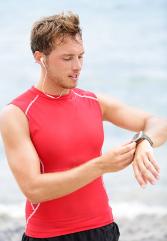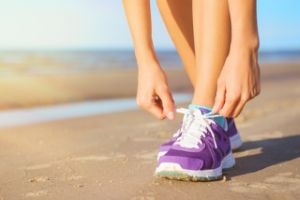Target training areas
We generally consider 5 training zones corresponding to heart rate ranges calculated from the maximum heart rate (FCmax) of the athlete. These values are fairly arbitrary and can vary from one method to another and especially from one individual to another. The athlete's training is carried out according to these effort ranges.
| Zone | HRmax | Activity |
|---|---|---|
| 1 | < 60 | Recovery, active rest |
| 2 | 60 - 70 | Basic endurance - light stamina |
| 3 | 70 - 80 | Low critical endurance - Hard core (aerobic) |
| 4 | 80 - 90 | Critical Endurance High - Core Intensity (Aerobic Lactic) |
| 5 | > 90 | Aerobic power (anaerobic zone) |
Zone 1 : recovery
This is the active recovery range following an effort.
Zone 2 : basic endurance
This zone allows the development of basic endurance, a crucial step when resuming training. It is important to work on it at least during the first 4 weeks of training. Basic endurance work promotes the development of muscle fibres, the opening of new blood capillaries useful for muscle oxygenation and the ability of capillaries to transport oxygen. It is sufficient to maintain endurance during a break in activity. It prepares the heart for the intense efforts to come.
Zone 3 : low critical endurance
It comes after basic endurance training. The objective is to accustom the body to sustained and long efforts. It allows the development of the aerobic system. We work on it by long outings (2 to 3 hours minimum).
Zone 4 : high critical endurance
This work zone follows the low critical endurance training. During training, the distance and intensity increase with each run. You can alternate 20-30 minutes in zone 4 with 20-30 minutes in zone 2.
Zone 5: aerobic power
This is the range that allows for sprint, anaerobic threshold elevation and VO2max work.
The anaerobic threshold is raised by working at the threshold (maximum 90 % of the FCmax) in short or long interval efforts alternating zones 2 and 5. For example, 20 seconds of sprint followed by 20 seconds of recovery or 1 to 3 minutes of aerobic power followed by 1 to 3 minutes in zone 2. The aim is to get the muscles used to the effects of lactic acid and thus to make them withstand greater efforts over longer periods of time.
See exercises to increase your anaerobic threshold.
The aim of sprinting is to develop explosive power. It is carried out by short but violent efforts.
Maximum aerobic power (MAP) is achieved by intense but short efforts (15 to 60 seconds) followed by the same amount of active recovery time (zone 1)
Plan your training and work outdoor or at home
A training session must be prepared. Allow a minimum of 20 weeks incorporating the work zones described above. You'll find practical advice in our Practical Guide for the Amateur Sportsman as well as in the advice pages of this site.
For winter preparation or as a complement to outdoor preparation, the home trainer allows you to effectively work on sprinting (explosive strength), PMA, VO2max, strength work, velocity, endurance, coordination, threshold work. We give many practical and motivating exercises and training plans in our Home Trainer Guide.
Determining your maximum heart rate (FCmax)
The maximum heart rate (HRmax) of a person is a fixed value that decreases with age. This value can be measured by an exercise or a test outside. It can also be evaluated by empirical formulas. The best-known ones:
- Astrand and Ryhming (1954): FCmax = 220 - age
- Inbar (1994): FCmax = 205.8 - 0.685 x age
- Robers and Lanwher (2002): HRmax = 208.754 - 0.734 x age
Some heart rate monitors give an approximate value based on age and a test lasting a few minutes at rest.
The test outsidex consists of warming up for at least 30 minutes and then gradually increasing your heart rate. Accelerate gradually to a time trial speed. Once the heart is accustomed, increase the pace in a climb for 3 minutes until you reach the anaerobic threshold and then finish with a sprint. This test is particularly demanding and should not be performed by the amateur athlete without prior medical advice.
Don't go into the red!
The red zone, or anaerobic limit, corresponds to the threshold at which the blood supply of oxygen is insufficient to allow the transformation of glucose and glycogen into energy usable by the muscle. Another energy-producing chemical reaction then takes place. This reaction produces a large quantity of lactic acid that the muscle cells are unable to assimilate. Its accumulation in the muscle is responsible for shortness of breath and even the well-known cramps or nausea. An athlete, even a trained one, cannot stay beyond the anaerobic threshold for very long, otherwise he will quickly burn out.
The red zone is situated between 90 and 95 % of the maximum heart rate in a trained athlete. In the under-trained athlete, this threshold varies from 80 to 85% of the maximum heart rate. It is the sensations experienced during the effort at the threshold associated with the use of a heart rate monitor that will allow this value to be measured approximately. There are also more precise tests to be performed on home-trainer or ergometric bicycle known as a spinning bike.
The red zone evolves with training. There are specific exercises that help push its value and thus push your limits. We give some of them in our Home Trainer Guide.
Optimize Your Training
Most cardo-frequency meters allow you to program an effort target zone with an audible signal when you go outside the set limits. This system is ideal for training plans where the intensity of the exercise is particularly important. The target zone is determined according to the objectives set (training, weight loss, etc.). In addition, the sound signal helps to keep your attention on the exercise rather than on the counter.
The heart rate monitor is also a very useful tool in the practice of home-trainer where the exercises require strict discipline especially in the calibration of the effort.
At a higher level, the post-race analysis of the athlete's cardiac activity recorded continuously during an outing is particularly useful for optimising the next outing. The trainer will highlight the times when the athlete could have given more of himself or on the contrary the excesses which could have led him into the red.
Maximum oxygen consumption or VO2max
Maximum oxygen consumption or VO2max (V for « volume », O2 for « Oxygen », max for « Maximum ») represents the maximum flow of oxygen consumed by muscles during an effort. In other words, it is the maximum quantity of oxygen that the body is able to extract from the air during an exercise. It is measured in millilitres per minute and per kilogram of weight. VO2max is to an athlete what the engine capacity is to an engine. The higher it is, the more endurance the athlete has. Learn more about VO2max.
Maximum Aerobic Power (MAP) and Maximum Aerobic Speed (MAS)
Oxygen consumption by the muscles is a linear function of the power developed, just like the heart rate. However, this consumption is limited: above a certain power, called the Maximum Aerobic Power (MAP), the maximum oxygen flow, or VO2max, is reached and cannot be exceeded. Other energy-producing reactions then come into play which do not consume oxygen but produce lactates. This is known as anaerobic work. The Maximum Aerobic Speed (MAS) is the speed that a runner working at MAP reaches.
VO2max and performance
VO2max varies from one individual to another and depends on his physiological characteristics. Its value can improve by 20 to 30 % with training. VO2max gives an indication of the level of fitness and endurance of an athlete. The higher its value, the more the athlete is able to maintain an effort over time.
Measure your VO2max

VO2max can be measured directly or indirectly.
The direct measurement consists of a test carried out in a hospital on a bicycle ergometer where, during an effort, the volumes of air inspired and expired are compared. The value obtained is reliable but the test is expensive to perform.
Indirect measurement makes it possible to obtain an approximate value of VO2max. Various methods exist to deduce its value.
As an indication, VO2max is around 40 ml/min/kg in sedentary men, 60 ml/min/kg in trained athletes and can reach 80 to 90 ml/min/kg in high level athletes. The values observed in women are about 30 to 35% lower than in men.
See why and how to measure your VO2max
Improve your VO2max
You can increase your VO2max through specific interval exercises. Also read our article on how to improve your VO2max.
The Maximum Aerobic Speed (MAS)
The Maximum Aerobic Speed or MAS is the maximum speed at which an athlete can run (or ride) in an endurance effort.
It corresponds to its maximum oxygen consumption (VO2max). Above this speed, oxygen consumption remains constant.
His/her body will then use a complementary energy system called anaerobic lactic capable of degrading glycogen without oxygen.
This process produces waste products, lactates (also called lactic acid by abuse of language), which alter muscle activity and force the athlete to reduce his pace.
In reality, the anaerobic system is triggered well before the MAS but to a small extent so that the body is able to eliminate the waste products produced.
The higher the MAS, the higher the endurance capacity. An athlete can run for about 6 minutes at his or her MAS.
Measure your MAS
For an athlete, the MAS ranges roughly from 14 km/h (average runner) to 26 km/h (high level athlete).
There are various methods of measuring MAS. We will mention two based on a constant pace test.
MAS test
Run for 6 minutes as fast as you can at a steady pace. Measure the distance you run and multiply it by 10 to get a speed in kilometres per hour. For example, if you ran 1.8 kilometres, your MAS is 18 km/h. If you are unable to maintain a constant pace, i.e. your speed decreases at the end or if, on the contrary, you are able to accelerate in the last few minutes, you have not reached your MAS. Rest and repeat the test!
Astrand's MAS test.
It consists of running for 3 minutes. You have to run as far as possible. The calculation of the MAS is done on the basis of 3 minutes 30. For example, if you have run 1 kilometre in 3 minutes, your MAS will be distance/time, i.e. 1/(3.5/60), which is 17 km/h.
The Leger-Boucher test (or shuttle test).
The athlete has to run on a track, gradually increasing his speed. The pace is set by a sound signal (recording). You have to reach a distance of 20 metres at each signal. The speed is increased by 1 km/h every 2 minutes. The test ends when the participant does not manage to reach the 20 metres in the allotted time. He then runs at his maximum aerobic speed (MAS). The VO2max is obtained by multiplying this speed by 3.5.
Hints for using the heart rate monitor
Run your abdominal belt under water before you leave to allow good contact between the electrodes and the skin.
If you use your cardio for cycling, buy a holder that you can attach to your handlebars so you don't have to look at your wrist regularly.
Choose a model with a coded belt: this system avoids interference with other heart rate monitors, a particularly important detail when riding in a group!
These articles may also interest you
Meilleures montres cardio GPS 2024 pour la course à pied
Running: 10 mistakes to avoid when starting out
Photo credit : Adobe Stock. This article contains commercial links.




